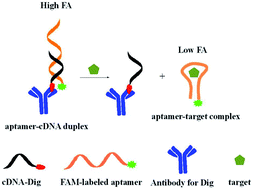Aptamer fluorescence anisotropy assays for detection of aflatoxin B1 and adenosine triphosphate using antibody to amplify signal change†
Abstract
Fluorescence polarization/anisotropy (FP/FA) is an attractive technology for determining small molecules in homogeneous solution based on rotation changes of a fluorescent reporter. Binding induced conformation change is a specific property of aptamers. This property has been integrated into aptamer based FA assays for small molecules. In this work, we reported aptamer FA assays for aflatoxin B1 (AFB1) and adenosine triphosphate (ATP) by using antibody conjugated complementary DNA at the 3′ end and a fluorescein (FAM)-labeled aptamer at the 5′ end. The hybridization of aptamer and cDNA induced a FAM label close to the large-sized antibody, which restricts the local rotation of FAM and gives high FA signal. With the addition of target, the aptamer probe binds with the target, and the aptamer–cDNA duplex is inhibited, causing FA signal decreases. This method achieved detection of 25 pM AFB1 and 1 μM ATP, respectively. The assay is promising for application.



 Please wait while we load your content...
Please wait while we load your content...